
Power transmission and fluid power solutions provider Gates Corporation (NYSE: GTES) met Wall Street’s revenue expectations in Q4 CY2024, but sales fell by 3.9% year on year to $829.4 million. Its non-GAAP profit of $0.36 per share was 8.7% above analysts’ consensus estimates.
Is now the time to buy Gates Industrial Corporation? Find out by accessing our full research report, it’s free.
Gates Industrial Corporation (GTES) Q4 CY2024 Highlights:
- Revenue: $829.4 million vs analyst estimates of $825.6 million (3.9% year-on-year decline, in line)
- Adjusted EPS: $0.36 vs analyst estimates of $0.33 (8.7% beat)
- Adjusted EBITDA: $180.8 million vs analyst estimates of $177.5 million (21.8% margin, 1.8% beat)
- Adjusted EPS guidance for the upcoming financial year 2025 is $1.44 at the midpoint, missing analyst estimates by 4.7%
- EBITDA guidance for the upcoming financial year 2025 is $765 million at the midpoint, below analyst estimates of $789.5 million
- Operating Margin: 13.6%, in line with the same quarter last year
- Free Cash Flow Margin: 20.2%, similar to the same quarter last year
- Organic Revenue fell 2.6% year on year (-4.6% in the same quarter last year)
- Market Capitalization: $5.29 billion
Ivo Jurek, Gates Industrial's Chief Executive Officer, commented, "In 2024, we generated a 180 basis point increase in our gross margin while encountering softer demand trends in many of our end markets. Our enterprise initiatives continue to gain traction. Furthermore, we also reduced our debt levels and repurchased $175 million of our stock."
Company Overview
Helping create one of the most memorable moments for the iconic “Jurassic Park” film, Gates (NYSE: GTES) offers power transmission and fluid transfer equipment for various industries.
Engineered Components and Systems
Engineered components and systems companies possess technical know-how in sometimes narrow areas such as metal forming or intelligent robotics. Lately, automation and connected equipment collecting analyzable data have been trending, creating new demand. On the other hand, like the broader industrials sector, engineered components and systems companies are at the whim of economic cycles. Consumer spending and interest rates, for example, can greatly impact the industrial production that drives demand for these companies’ offerings.
Sales Growth
A company’s long-term sales performance can indicate its overall quality. Any business can put up a good quarter or two, but many enduring ones grow for years. Over the last five years, Gates Industrial Corporation grew its sales at a sluggish 2% compounded annual growth rate. This was below our standards and is a poor baseline for our analysis.
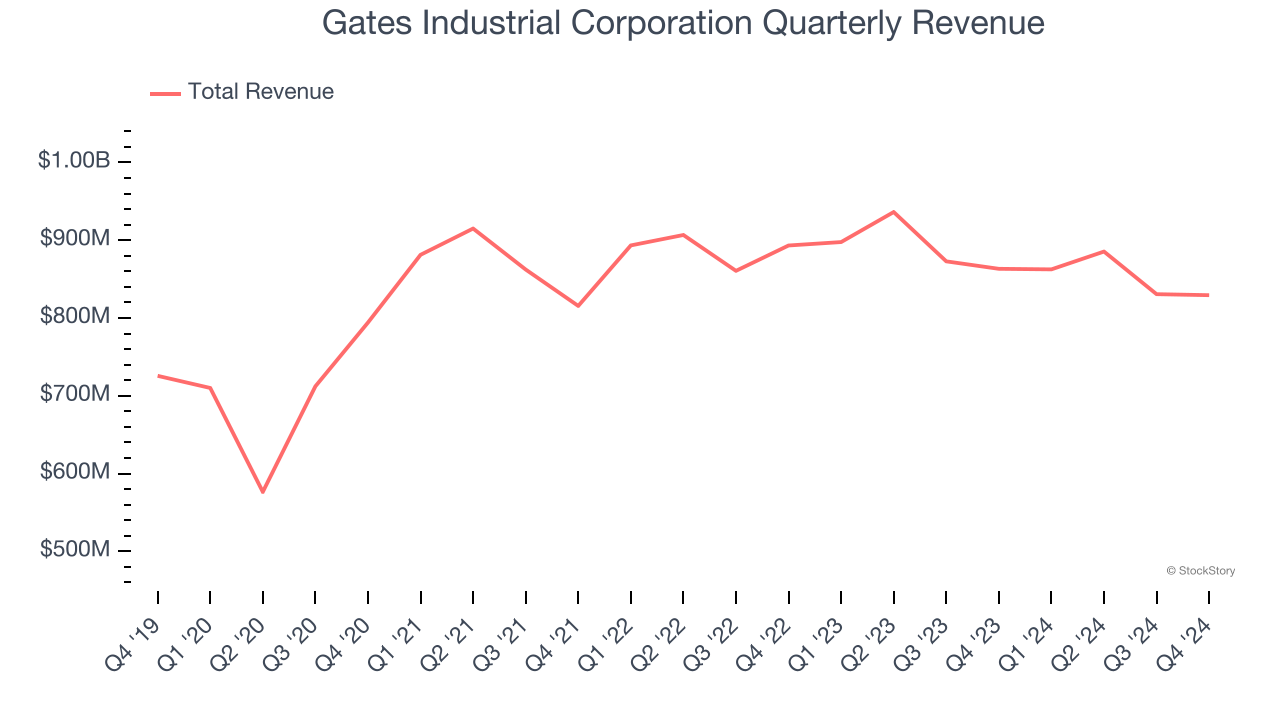
Long-term growth is the most important, but within industrials, a half-decade historical view may miss new industry trends or demand cycles. Gates Industrial Corporation’s history shows it grew in the past but relinquished its gains over the last two years, as its revenue fell by 2.1% annually. 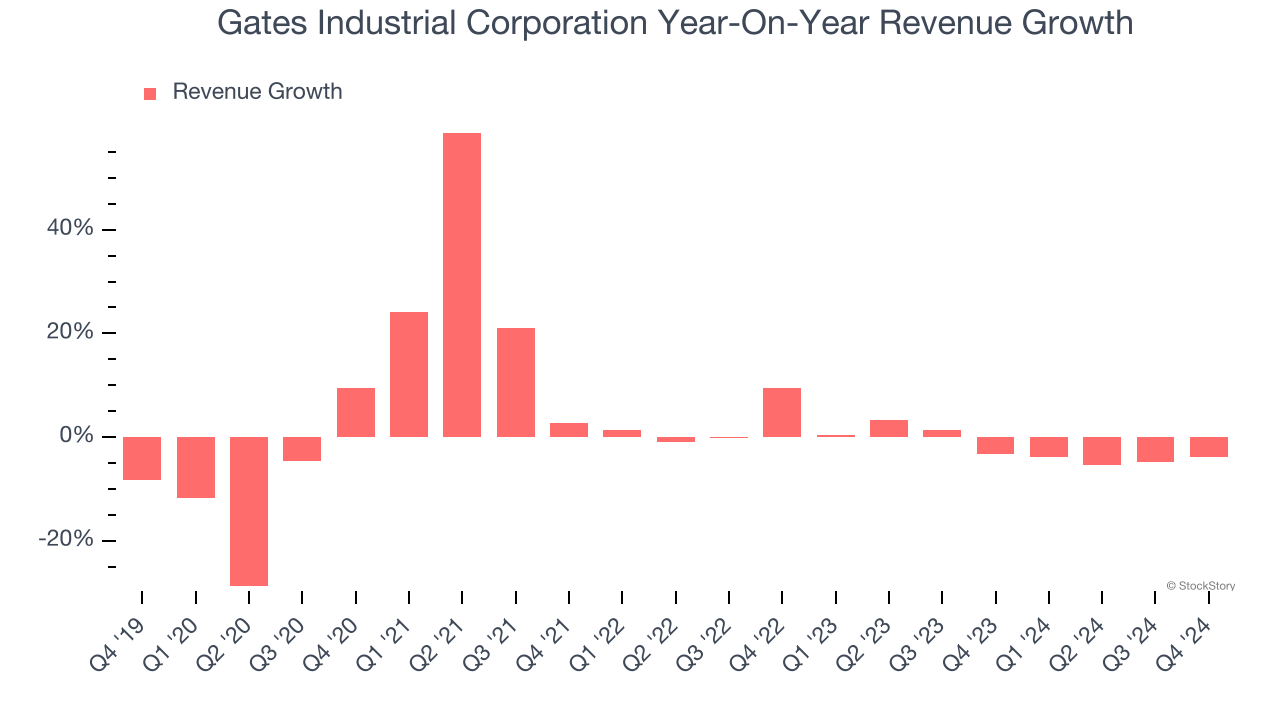
Gates Industrial Corporation also reports organic revenue, which strips out one-time events like acquisitions and currency fluctuations that don’t accurately reflect its fundamentals. Over the last two years, Gates Industrial Corporation’s organic revenue averaged 1.4% year-on-year declines. Because this number aligns with its normal revenue growth, we can see the company’s core operations (not acquisitions and divestitures) drove most of its results. 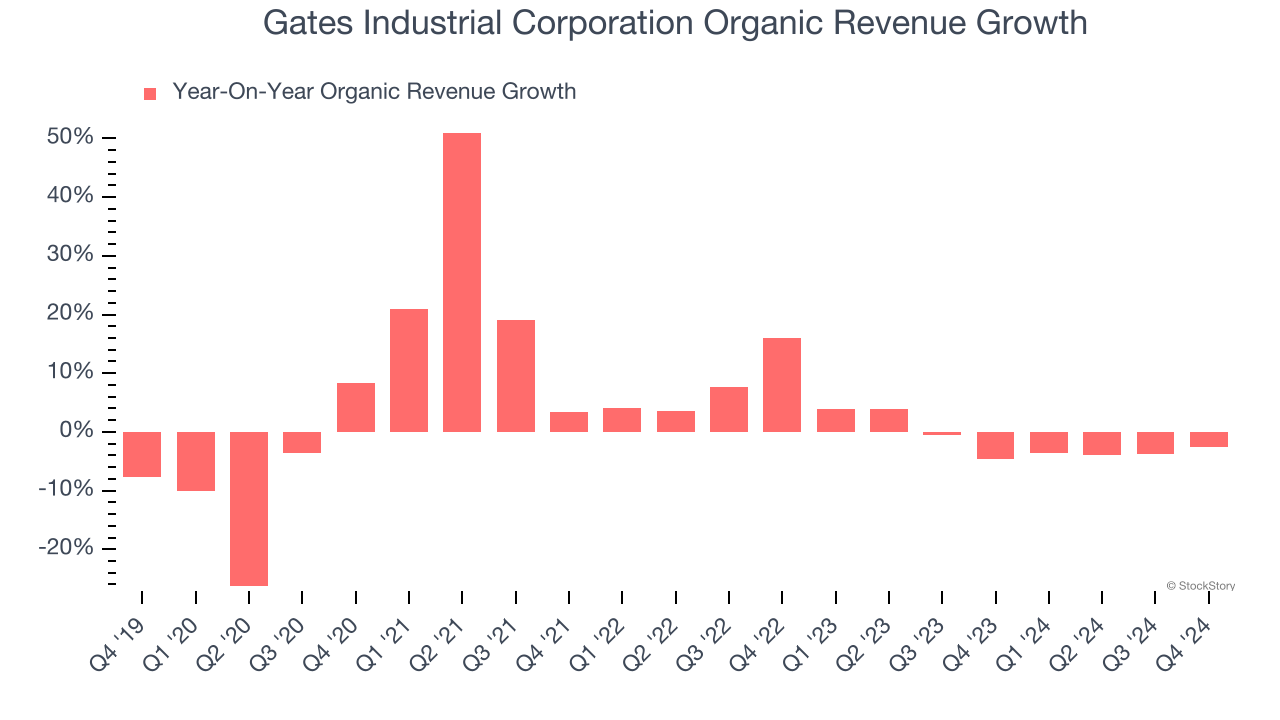
This quarter, Gates Industrial Corporation reported a rather uninspiring 3.9% year-on-year revenue decline to $829.4 million of revenue, in line with Wall Street’s estimates.
Looking ahead, sell-side analysts expect revenue to grow 2% over the next 12 months. While this projection suggests its newer products and services will catalyze better top-line performance, it is still below the sector average.
Here at StockStory, we certainly understand the potential of thematic investing. Diverse winners from Microsoft (MSFT) to Alphabet (GOOG), Coca-Cola (KO) to Monster Beverage (MNST) could all have been identified as promising growth stories with a megatrend driving the growth. So, in that spirit, we’ve identified a relatively under-the-radar profitable growth stock benefiting from the rise of AI, available to you FREE via this link.
Operating Margin
Gates Industrial Corporation has been an efficient company over the last five years. It was one of the more profitable businesses in the industrials sector, boasting an average operating margin of 12%. This result isn’t surprising as its high gross margin gives it a favorable starting point.
Looking at the trend in its profitability, Gates Industrial Corporation’s operating margin rose by 6.5 percentage points over the last five years, showing its efficiency has meaningfully improved.
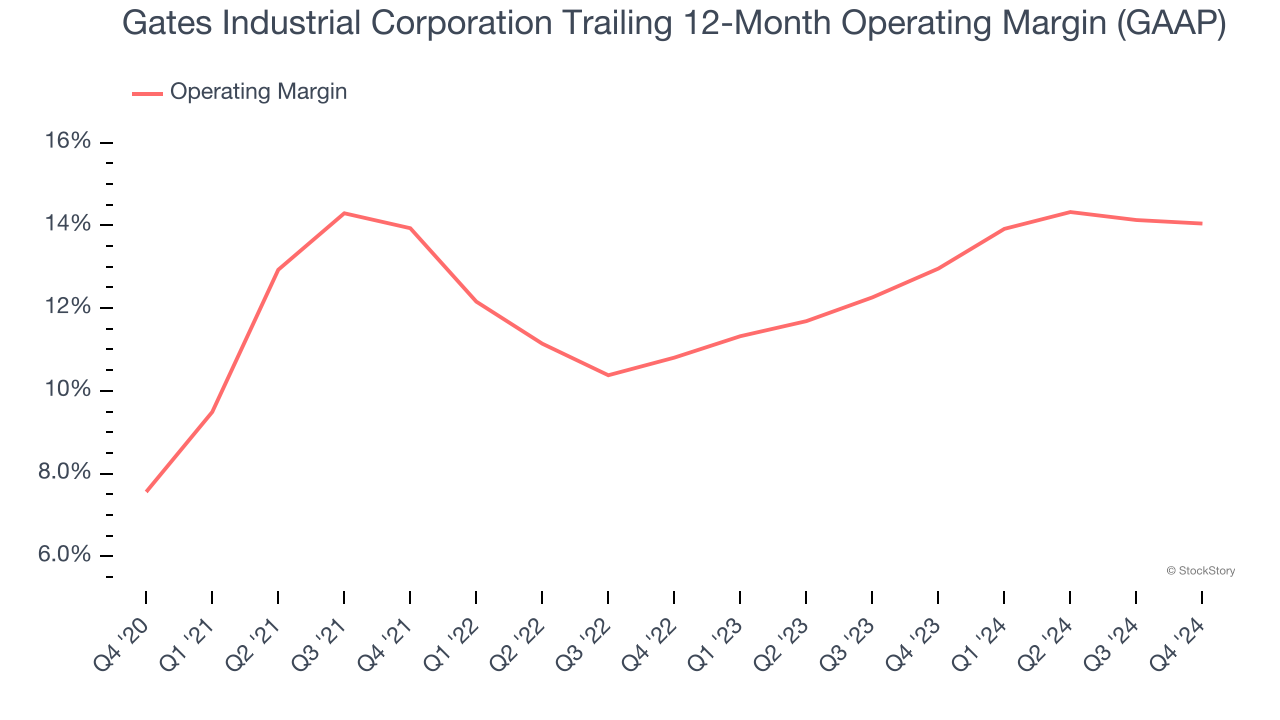
This quarter, Gates Industrial Corporation generated an operating profit margin of 13.6%, in line with the same quarter last year. This indicates the company’s cost structure has recently been stable.
Earnings Per Share
We track the long-term change in earnings per share (EPS) for the same reason as long-term revenue growth. Compared to revenue, however, EPS highlights whether a company’s growth is profitable.
Gates Industrial Corporation’s EPS grew at an unimpressive 7.8% compounded annual growth rate over the last five years. On the bright side, this performance was better than its 2% annualized revenue growth and tells us the company became more profitable on a per-share basis as it expanded.
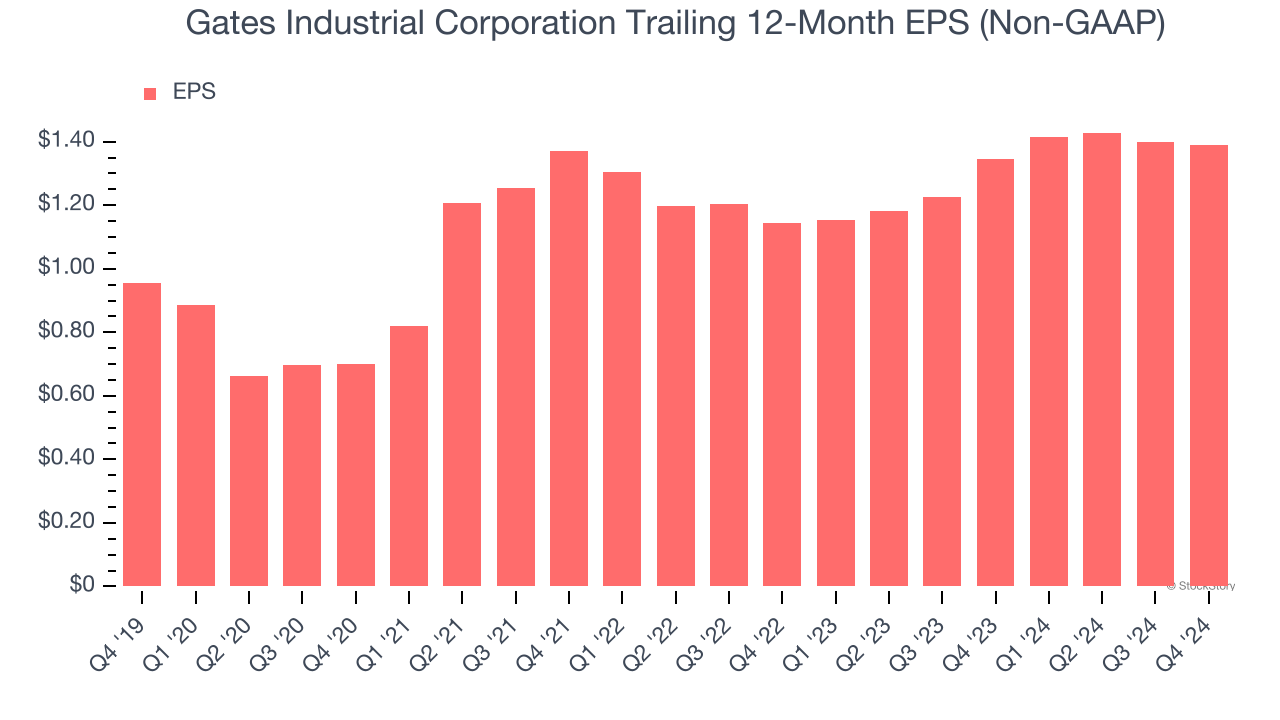
We can take a deeper look into Gates Industrial Corporation’s earnings to better understand the drivers of its performance. As we mentioned earlier, Gates Industrial Corporation’s operating margin was flat this quarter but expanded by 6.5 percentage points over the last five years. On top of that, its share count shrank by 12.5%. These are positive signs for shareholders because improving profitability and share buybacks turbocharge EPS growth relative to revenue growth. 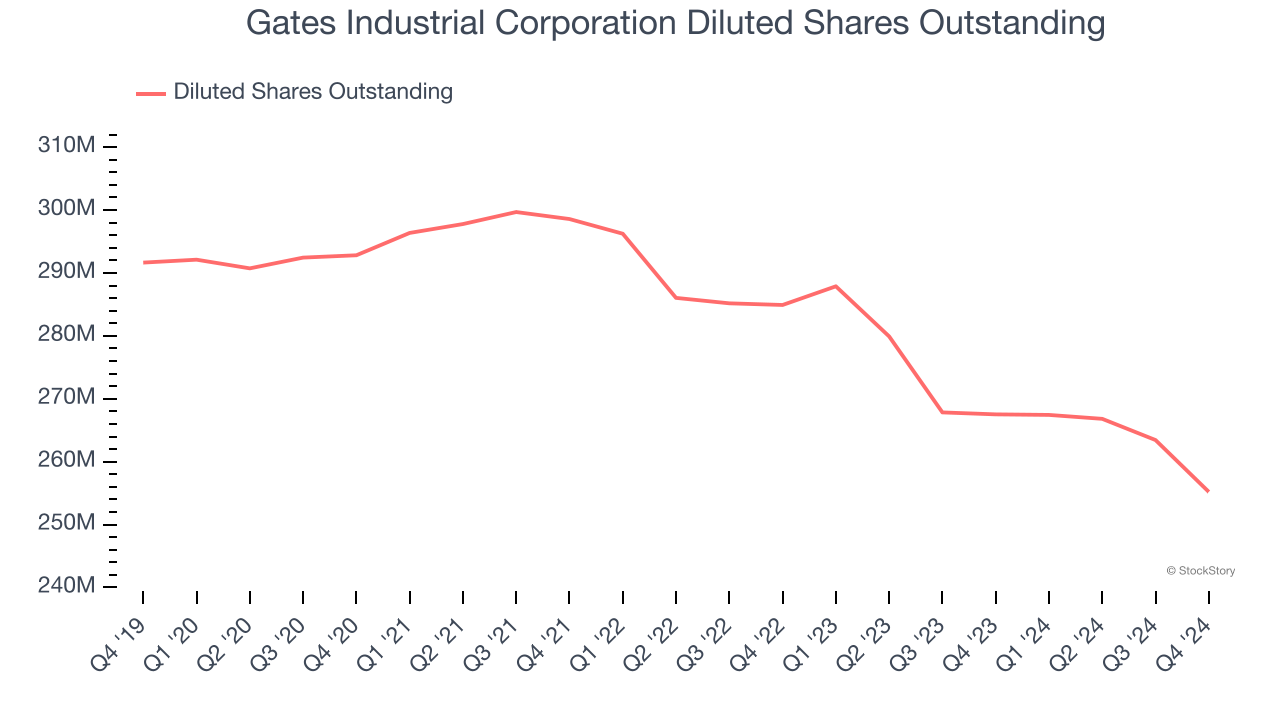
Like with revenue, we analyze EPS over a more recent period because it can provide insight into an emerging theme or development for the business.
For Gates Industrial Corporation, its two-year annual EPS growth of 10.3% was higher than its five-year trend. This acceleration made it one of the faster-growing industrials companies in recent history.
In Q4, Gates Industrial Corporation reported EPS at $0.36, in line with the same quarter last year. This print beat analysts’ estimates by 8.7%. Over the next 12 months, Wall Street expects Gates Industrial Corporation’s full-year EPS of $1.39 to grow 8%.
Key Takeaways from Gates Industrial Corporation’s Q4 Results
It was encouraging to see Gates Industrial Corporation beat analysts’ EPS and EBITDA expectations this quarter. On the other hand, its full-year guidance for both metrics fell short. Zooming out, we think this was a mixed quarter. The stock remained flat at $20.77 immediately following the results.
Big picture, is Gates Industrial Corporation a buy here and now? We think that the latest quarter is only one piece of the longer-term business quality puzzle. Quality, when combined with valuation, can help determine if the stock is a buy. We cover that in our actionable full research report which you can read here, it’s free.






